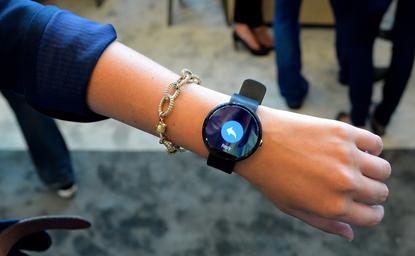Google looks into a future with 3D tablets, interactive animation
- 27 June, 2014 05:38

Motorola 360 smartwatch
In Google's vision of the future, tablets will provide a 3D view of the world and smartphones will have uses that haven't been thought of yet.
On the second day of the annual Google I/O developer conference, Google focused on its Advanced Technology and Projects (ATAP) group and the future-leaning work it's doing.
Regina Dugan, the leader of ATAP, described her group as "a small band of pirates" whose goal "is to close the gap between what could be and what is. No one comes to build a career in ATAP. You come to build something -- to do your best work."
One of the things Dugan's team announced was that it plans to award $100,000 to the developer who comes up with the best new use for a smartphone. The key is that the idea needs to be developed into a working technology.
It's not clear yet on the timetable for the challenge.
However, there is a new timeframe for the work coming out of Project Tango, the company's effort to create tablets and smartphones that are 3D-enabled.
Johnny Chung Lee, Google's Project Tango lead, said Google is teaming with LG Electronics to build a 3D tablet that is scheduled to go on sale sometime in 2015.
"We want to give devices a human-scale understanding of space and motion," Lee told the audience. "You, sitting in your seat, roughly understand the size of the room. That's remarkable, but we take it for granted every day... Using 3D sensors and cameras, we can give that sense of place to devices."
Lee showed a tablet with a 4-megapixel camera, a motion-tracking camera and integrated depth sensors. He walked around the stage with the tablet to show how the device could create a 3D rendering of the space around him.
"We combine tracking data and sensing data and we can fuse that into an estimate of the device's position and environment," Lee said. "We can use 3D and get a sense of position without GPS."
Paul Eremenko, a roboticist and head of Google's Project Ara group, said his team is focused on asking what would be possible if we asked for more from our smartphones. Project Ara is working to develop a free, open hardware platform that can be used to create modular smartphones.
"What if we asked better questions of our phones? What if my phone could test to find out if my water is clean?" Eremenko said. "Why choose a phone for its camera when you could choose your camera for its phone?"
Eremenko's group is the one awarding $100,000 to the developer who comes up with the best new use for a smartphone.
Dugan, a former director of DARPA (the Defense Advanced Research Projects Agency), the research arm of the U.S. Defense Department, also talked about using mobile devices to rethink the way we tell stories.
She was joined on stage by Glen Keane, a Disney Co., artist who created animated characters like Ariel from The Little Mermaid, as well as the title characters for the animated movies Aladdin, Pocahontas, and the Beast from Beauty and the Beast.
Keane has been working with Google's technical team to create an interactive animated film, dubbed Duet, for mobile platforms. Duet is scheduled to be released later this year.
"One day we hope to have a new type of film festival... one that is mobile," Dugan said.
Keane added, "I see myself as an artist first. Fortunately, everything I've animated has tested me in learning something new. In embracing this new technology, I feel like I've rediscovered a love for animation."
The keynote from Google's annual I/O developers conference was jam-packed this year, covering everything from an upcoming Android operating system to wearables, such as the Motorola 360 smartwatch (pictured). What do you think was Google's biggest announcement?What's the most important announcement from this year's Google I/O?
This article, Google looks into the future with 3D tablets, interactive animation, was originally published at Computerworld.com.
